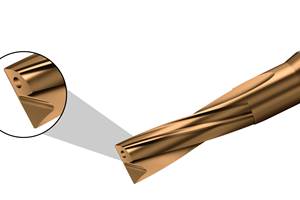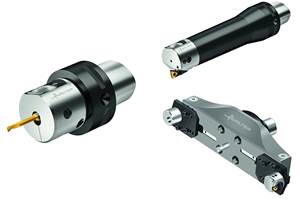Mold Maker Reduces Cycle Time 50 Percent With New Drilling System
Despite a 120 hour week and frequent overtime, Special Mold Engineering Inc. (Rochester Hills, Michigan) didn't have enough deephole drilling capacity to keep up with customer demand for its injection mold bases. So it reluctantly farmed out some of the gundrilling for the excess.
Despite a 120 hour week and frequent overtime, Special Mold Engineering Inc. (Rochester Hills, Michigan) didn't have enough deephole drilling capacity to keep up with customer demand for its injection mold bases. So it reluctantly farmed out some of the gundrilling for the excess.
The company makes mold bases and preform tools for the consumer product, automotive, pharmaceutical, computer and telecommunications industries. The molds are made of 420 stainless steel or 4140 steel, and each mold has anywhere from 10 to 100 holes, many of them intersecting. Hole depths run from 3 to 42 inches, and the hole drilling operation, in a two machine cell concept, requires multiple tools and setups. An average mold plate takes three to eight hours to drill, and there are five to eight plates to a mold.
Knowing SME preferred to keep the injection mold bases in-house, its tooling vendor, Dynamic Tool & Abrasives (Ferndale, Michigan), suggested a switch from traditional gundrilling to single tube drilling for holes with diameters larger than 0.50 inch. Then, SME was approached by Sandvik Coromant Company (Fair Lawn, New Jersey) to try its new single tube deephole drilling system. Since it had been looking for a solution to the capacity problem, the company decided to investigate to try to find one.
The new deephole drilling tool is the STS (single tube system) drill. This drill removes chips through an internal tube, eliminating all the problems of chip binding which often occur with conventional deep hole drills.
Mark Percival, SME's Sandvik technical sales representative, brought in the new tool and tested it on a dummy part. He was able to run almost twice as fast immediately and generate intersecting holes without having to swap tools. Convinced by these preliminary results, David MacDonald, manufacturing engineer and operations manager, ordered a set of STS drills and asked the gundrill manufacturer to convert the machine to take the new system. Five Sandvik drill heads in 1/2-, 9/16-, 15/16-, 1 1/16- and 1 1/8-inch sizes cover SME's needs.
A typical component, such as a preform tool for plastic bottles, has hundreds of cooling holes. Operators start by clamping the workpiece to the machine, gundrilling the small diameter holes first, then switching to the STS drill to completely do one side. They then turn the workpiece and reclamp it to work on the other sides.
Maintaining straightness, roundness, diameter and finish specifications in the deep hole drilling operation required slowing down feed rates. For a 15/16-inch diameter gundrill, for example, maximum feed rate was 1 to 1.2 ipm and the tool dulled within 200 inches of drilling. The single edge on the existing drills would break under high cutting loads if they tried to go faster.
"In deep holes, the deeper you drill, the further the chip must travel, and the greater the chance of jamming or binding on the way out," explains Mr. Percival. "The friction between drill, chip and hole wall can dramatically build up torsional forces and snap the drill."
With the STS drill, operators increased feed up to 8 ipm for standard cooling holes and 4 ipm for intersecting holes. As a result, they cut part cycle time by up to 50 percent. And, there is no problem with tool instability or surface finish. There are hardly any breakages, and tooling inventory and cost are down by 20 to 30 percent as a result.
The STS drill is only available for 15 percent of the drilling workload, but the total cycle time savings went from 12 hours to 6 hours, including the 1/2 hour required for switching drill heads back and forth. Operators remove 300 inches of material before the tips dull and are disposed.
Mr. Percival says that the improved hole finish is the result of rigidity and better chip removal. Since chip evacuation is internal, no groove is required in the tube shank, so the completely round crosssection provides stability for depths to diameter ratios of up to 100:1.
Internal chip evacuation—through the hollow drill shaft—eliminates all the problems of chip binding and jamming. With STS drilling, incoming cutting fluid is pumped to the cutting face through the annular space between the outside of the tube and the wall of the hole itself. Then the cutting fluid exits through the tubular drill shank, carrying the chips along with it.
SME's decision to upgrade to modern tooling proved to be the most cost effective alternative for meeting its capacity requirements. It improved process economics, saved on tooling, and holes are more true to specification than before.
Related Content
Form Tapping Improves Tool Life, Costs
Moving from cut tapping to form tapping for a notable application cut tooling costs at Siemens Energy and increased tool life a hundredfold.
Read MoreTungaloy Expands Drill System With Drill Sleeves
Adding drill sleeves to the standard lineup enhances drilling productivity of Swiss-type sliding-head automatic lathes.
Read MoreWalter Launches New Solid Carbide Drill
The DC118 Supreme solid carbide drill provides high rigidity against deflection, superior centering accuracy and four margins with corner chamfers.
Read MoreWalter Extends Line of Precision Boring Tools
The new boring tools employ modular components such as cartridge holders and extensions, which are matched to the system, utilize an extensive range of indexable inserts suited for precision boring and can be used for all material groups.
Read MoreRead Next
3 Mistakes That Cause CNC Programs to Fail
Despite enhancements to manufacturing technology, there are still issues today that can cause programs to fail. These failures can cause lost time, scrapped parts, damaged machines and even injured operators.
Read MoreThe Cut Scene: The Finer Details of Large-Format Machining
Small details and features can have an outsized impact on large parts, such as Barbco’s collapsible utility drill head.
Read More








.png;maxWidth=300;quality=90)
















